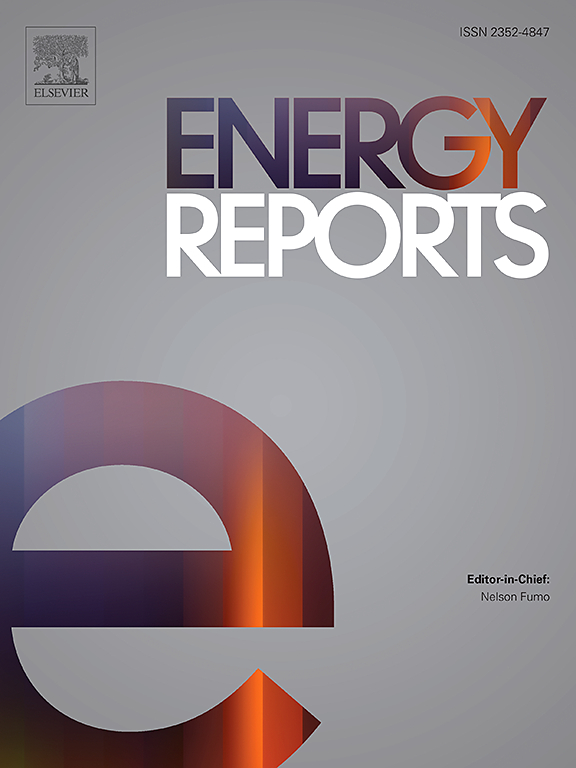Power quality improvement in Grid‐Connected PV system using fractional order controller and Fractional-order Lipschitz Recurrent Neural Network (FLRNN)
IF 5.1
3区 工程技术
Q2 ENERGY & FUELS
引用次数: 0
Abstract
In hybrid renewable energy systems (HRES), particularly with solar, fuel cell, and battery components, common PQ disturbances that occur are voltage sags, swells, and fluctuations. An intelligent FLRNN-FOPID-DSTATCOM control framework is proposed that integrates a Fractional-Order PID (FOPID) controller, whose parameters are optimized using a novel Draft-Mongoose Tailored Earthworm Optimizer (DTEO), and a Fractional-Order Lipschitz Recurrent Neural Network (FLRNN), for PQ improvement under varying load and source conditions. The simulated experimental setup used the MATLAB/Simulink environment, after which this approach underwent a rigorous comparative study with traditional PID, Meta-heuristic PI/PID, and Sliding Mode Controllers (SMC). The quantitative nature of the results proves a substantial reduction of THD down to 0.0043 from undefined baseline THD values, signifying very good harmonic suppression. The system is able to stabilize the PV voltage and current from varying ranges of −200 V to 350 V and −800 A to 300 A, respectively, to steady outputs of 350 V and 300 A. While the battery and DC-link voltages are restored from momentary dips as low as 200 V to steady state voltages of 270–300 V, variability due to voltage sags, swells, and fluctuations are suppressed such that LV is stabilized within ±2.5–3 V and IC ramped effectively to ±500–598 A. Therefore, compared to the existing methods, the proposed controller greatly reduces THD more swiftly with better dynamic response and adaptability to PV variability, saving times required for the neural network training. From the above results, the proposed technique can be considered as a promising high-performance method to enhance power quality in real-time in a grid-connected HRES environment.
基于分数阶控制器和分数阶Lipschitz递归神经网络(FLRNN)的并网光伏系统电能质量改进
在混合可再生能源系统(HRES)中,特别是太阳能、燃料电池和电池组件,常见的PQ干扰是电压下降、膨胀和波动。提出了一种FLRNN-FOPID- dstatcom智能控制框架,该框架集成了分数阶PID控制器(FOPID)和分数阶Lipschitz递归神经网络(FLRNN),该控制器的参数通过一种新型Draft-Mongoose Tailored Earthworm Optimizer (DTEO)进行优化,以改善不同负载和源条件下的PQ。在MATLAB/Simulink环境下进行了仿真实验,并与传统PID、元启发式PI/PID和滑模控制器(SMC)进行了严格的比较研究。结果的定量性质证明THD从未定义的基线THD值大幅降低至0.0043,表明非常好的谐波抑制。系统能够将PV电压和电流分别稳定在- 200 V ~ 350 V和- 800 A ~ 300 A的范围内,稳定输出为350 V和300 A。当电池和直流链路电压从低至200 V的瞬间下降恢复到270-300 V的稳态电压时,电压跌落、膨胀和波动引起的可变性被抑制,使得低压稳定在±2.5-3 V, IC有效地上升到±500-598 A。因此,与现有方法相比,该控制器具有更好的动态响应和对PV变异性的适应性,能够更快地降低THD,节省了神经网络的训练时间。从以上结果来看,该技术可以被认为是一种很有前途的高性能方法,可以实时提高并网HRES环境下的电能质量。
本文章由计算机程序翻译,如有差异,请以英文原文为准。
求助全文
约1分钟内获得全文
求助全文
来源期刊

Energy Reports
Energy-General Energy
CiteScore
8.20
自引率
13.50%
发文量
2608
审稿时长
38 days
期刊介绍:
Energy Reports is a new online multidisciplinary open access journal which focuses on publishing new research in the area of Energy with a rapid review and publication time. Energy Reports will be open to direct submissions and also to submissions from other Elsevier Energy journals, whose Editors have determined that Energy Reports would be a better fit.
 求助内容:
求助内容: 应助结果提醒方式:
应助结果提醒方式:


